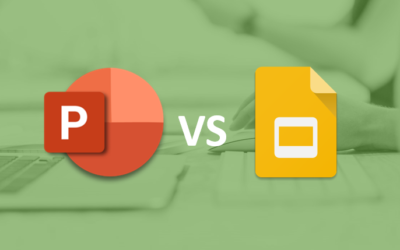Microsoft PowerPoint 2013 Version Overview
If you're considering upgrading to Microsoft PowerPoint 2013 before attending a training course or arranging custom training, check out this list of some of the new features in PowerPoint 2013.
If you are using PowerPoint 2016 or considering upgrading to PowerPoint 2016, see the Microsoft PowerPoint 2016 Overview.
Are you working on PowerPoint 2010? Check out new features in the Microsoft PowerPoint 2010 Overview.
Looking for PowerPoint training courses?
Microsoft PowerPoint 2013 New Features
Applies to: Microsoft PowerPoint 2013 for Windows
The following are some of the key new features available in Microsoft PowerPoint 2013.
Default Widescreen Format
In PowerPoint 2013, the default format is widescreen or 16:9. However, if you're printing slides, they won't convert to print as 1 slide per page as easily as the 4:3 size (Microsoft recommends printing widescreen 2 slides per page).
There are a number of widescreen templates that are included with PowerPoint 2013. Also, if you switch from 4:3 to widescreen, graphics will need to be resized. It's best to start in widescreen if that is how you intend to run your presentation.
Enhanced Theme Options
There are new theme options or variations in PowerPoint 2013. Click on the Design tab on the Ribbon and you'll be able to choose between different themes and variations.
New Animations
PowerPoint 2013 features four new animations. There are two new entrance effects and two new exit effects.
Compress is available as an entrance and exit effect. There is also a Stretch entrance and a Collapse exit effect.
New Slide Transitions
There are 11 new transitions and Microsoft has brought back the random transition option.
The new transitions are:
- Fracture
- Crush
- Peel Off
- Fall Over
- Drape
- Curtains
- Page Curl
- Airplane
- Origami
- Wind
- Prestige
- Random
Improved Presenter View
In PowerPoint 2013, the improved Presenter View allows you to easily view the current slide, the notes for your current slide and a preview of the next slide. This view is seen only by the presenter while the audience views the current slide.
To launch Presenter View, press Alt + F5 to start your presentation from the beginning in Presenter View or press Alt + Shift + ALT + F5 to start Presenter View at the current slide.
You now also have a variety of options in Presenter View – a laser pointer / pen / highlighter, slide sorter, zoom and an option to switch between black screen and the current slide.
New Video and Audio Formats and Features
PowerPoint 2013 has a number of newly-supported audio and video formats that can now be viewed in PowerPoint without having to download other applications (such as QuickTime). The ability to include MP4 videos which play smoothly without adding QuickTime is a great improvement for those using video.
The following video formats are now supported in 2013 (the default is MP4):
- MP4 video file (.mp4, .m4v, .mov)
- Windows media file (.asf)
- Windows video file (.avi)
- Movie file (.mpg or .mpeg)
- Adobe Flash media (.swf)
- Windows media video file (.wmv)
The following audio formats are now supported in 2013:
- AIFF audio file (.aiff)
- AU audio file (.au)
- MIDI file (.mid or .midi)
- MP3 audio file (.mp3)
- MPEG-4 audio file (.m4a, .mp4)
- Windows audio file (.wav)
- Windows media audio file (.wma)
Feature enhancements include:
- Music can be played in the background easily with the Play in background feature.
- You can now drag and drop media files from folders directly into a presentation.
- In 2013, you can also export PowerPoint presentations to MP4 video instead of just Windows media video (wmv).
Match Colours using the Eye Dropper Tool
You can now match colours with the Eye Dropper tool. This tool allows you to pick up a color from another object and paste it to a different object.
Contact us to discuss any of our custom options.
Check out our blog for more PowerPoint tips, tricks and shortcuts.
Public courses are delivered at our downtown Toronto location at 1 Yonge Street, Suite 1801 (Toronto Star Building), Toronto, Ontario, Canada.
Do you need more information? Contact us!
Copyright 2017 Avantix Learning Inc.
To request this page in an alternate format, contact our staff.

Custom training
Register for a public course or contact us to arrange custom training at your site or ours.
Related courses
Microsoft PowerPoint: Introduction
Microsoft PowerPoint: Intermediate / Advanced
Microsoft PowerPoint: Design for Non-Designers
You may like
PowerPoint vs Google Slides (Full Feature Comparison + Benefits)
When comparing PowerPoint vs Google Slides (and trying to decide which is the better choice for your needs), you will need to consider versions when you compare the two applications. In this article, we'll compare the desktop or downloadable version of PowerPoint vs Google Slides, an online program that works in a browser. The key difference then if you are comparing PowerPoint vs Google Slides is that PowerPoint must be downloaded and runs on your desktop and Google Slides runs online. The desktop version of PowerPoint is a robust, full-featured program with many advanced features. You can buy PowerPoint as a stand-alone version or as part of a Microsoft 365 subscription. If you are a 365 subscriber, new features roll out on a regular basis.
3 Ways to Insert or Type the Euro Symbol in PowerPoint (€)
You can insert the euro sign or symbol (€) in a PowerPoint presentation using built-in PowerPoint commands or keyboard shortcuts (Alt code or AutoCorrect shortcuts).
How to Show or Unhide the Quick Access Toolbar in Word, Excel and PowerPoint
In 2021 and 365 versions of Word, Excel and PowerPoint, you now have the ability to hide or unhide the Quick Access Toolbar. So if your Quick Access Toolbar seems to have disappeared, it may simply be hidden. In 2021, Microsoft also removed Undo and Redo / Repeat from the Quick Access Toolbar and moved these commands to the Home tab in the Ribbon.
You may also like
How to Show or Hide Gridlines in Excel
You can remove or hide gridlines in Excel worksheets to simplify worksheet design. By default, gridlines are displayed but do not print. Gridlines are applied to entire worksheets or workbooks, not to specific cells. If you hide gridlines on one worksheet, it doesn't affect other sheets in the same workbook.
How to Combine First and Last Name in Excel (5 Ways)
You can combine first and last name in Excel in several ways – using the CONCATENATE operator, the CONCATENATE function, the CONCAT function, the TEXTJOIN function or Flash Fill. These functions are often used to combine text in cells but you can also combine text with spaces, commas, dashes or another character. It's common to combine first and last names that appear in two columns into one new column. Some functions are only available in newer versions of Excel but the CONCATENATE operator and function are available in all versions.
How to Insert Multiple Columns in Excel (4 Fast Ways with Shortcuts)
You can quickly insert multiple columns in Excel using a drop-down menu, keyboard shortcuts or the Home tab in the Ribbon. The key to inserting multiple columns at once, rather than one by one, is to select the number of columns you want to insert first and then insert columns. Excel will insert the same number of columns you selected.
Microsoft, the Microsoft logo, Microsoft Office and related Microsoft applications and logos are registered trademarks of Microsoft Corporation in Canada, US and other countries. All other trademarks are the property of the registered owners.
Avantix Learning | 1 Yonge Street, Suite 1801 (Toronto Star Building), Toronto, Ontario, Canada M5E 1W7 | info@avantixlearning.ca






